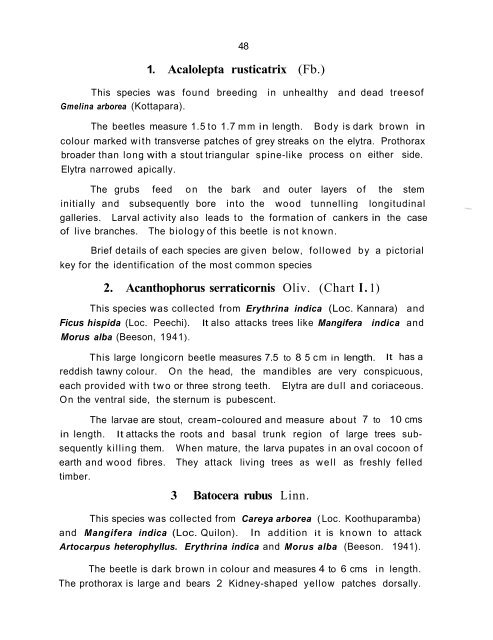a survey of beetles damaging commercially impotrtant ... - Icrisat.ac.in
a survey of beetles damaging commercially impotrtant ... - Icrisat.ac.in
a survey of beetles damaging commercially impotrtant ... - Icrisat.ac.in
Create successful ePaper yourself
Turn your PDF publications into a flip-book with our unique Google optimized e-Paper software.
481. Acalolepta rusticatrix (Fb.)This species was found breed<strong>in</strong>gGmel<strong>in</strong>a arborea (Kottapara).<strong>in</strong> unhealthy and dead trees<strong>of</strong>The <strong>beetles</strong> measure 1.5 to 1.7 mm <strong>in</strong> length.Body is dark brown <strong>in</strong>colour marked with transverse patches <strong>of</strong> grey streaks on the elytra. Prothoraxbroader than long with a stout triangular sp<strong>in</strong>e-like process on either side.Elytra narrowed apically.The grubs feed on the bark and outer layers <strong>of</strong> the stem<strong>in</strong>itially and subsequently bore <strong>in</strong>to the wood tunnell<strong>in</strong>g longitud<strong>in</strong>algalleries. Larval <strong>ac</strong>tivity also leads to the formation <strong>of</strong> cankers <strong>in</strong> the case<strong>of</strong> live branches. The biology <strong>of</strong> this beetle is not known.Brief details <strong>of</strong> e<strong>ac</strong>h species are given below, followed by a pictorialkey for the identification <strong>of</strong> the most common species2. Acanthophorus serraticornis Oliv. (Chart I. 1)This species was collected from Erythr<strong>in</strong>a <strong>in</strong>dica (Loc. Kannara) andFicus hispida (Loc. Peechi).Morus alba (Beeson, 1941 ).It also att<strong>ac</strong>ks trees like Mangifera <strong>in</strong>dica andThis large longicorn beetle measures 7.5 to 8 5 cm <strong>in</strong> length. It has areddish tawny colour. On the head, the mandibles are very conspicuous,e<strong>ac</strong>h provided with two or three strong teeth. Elytra are dull and cori<strong>ac</strong>eous.On the ventral side, the sternum is pubescent.The larvae are stout, cream-coloured and measure about 7 to 10 cms<strong>in</strong> length. It att<strong>ac</strong>ks the roots and basal trunk region <strong>of</strong> large trees subsequentlykill<strong>in</strong>g them. When mature, the larva pupates <strong>in</strong> an oval cocoon <strong>of</strong>earth and wood fibres. They att<strong>ac</strong>k liv<strong>in</strong>g trees as well as freshly felledtimber.3 Batocera rubus L<strong>in</strong>n.This species was collected from Careya arborea ( Loc. Koothuparamba)and Mangifera <strong>in</strong>dica (Loc. Quilon). In addition it is known to att<strong>ac</strong>kArtocarpus heterophyllus. Erythr<strong>in</strong>a <strong>in</strong>dica and Morus alba (Beeson. 1941).The beetle is dark brown <strong>in</strong> colour and measures 4 to 6 cms <strong>in</strong> length.The prothorax is large and bears 2 Kidney-shaped yellow patches dorsally.

















